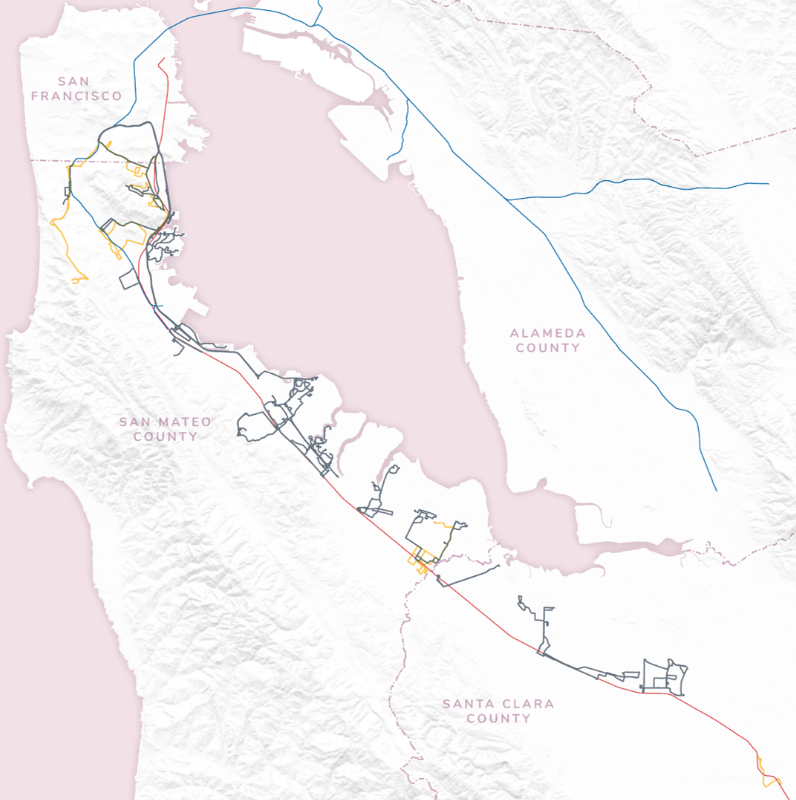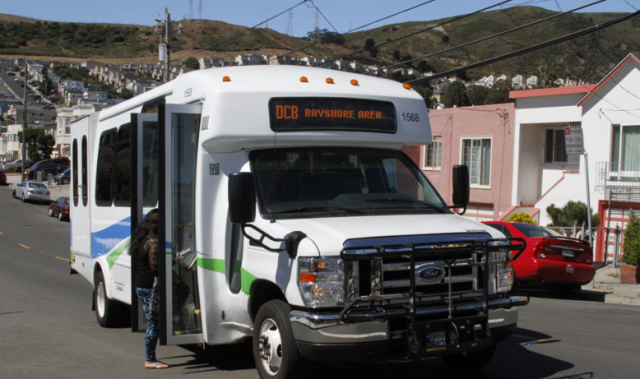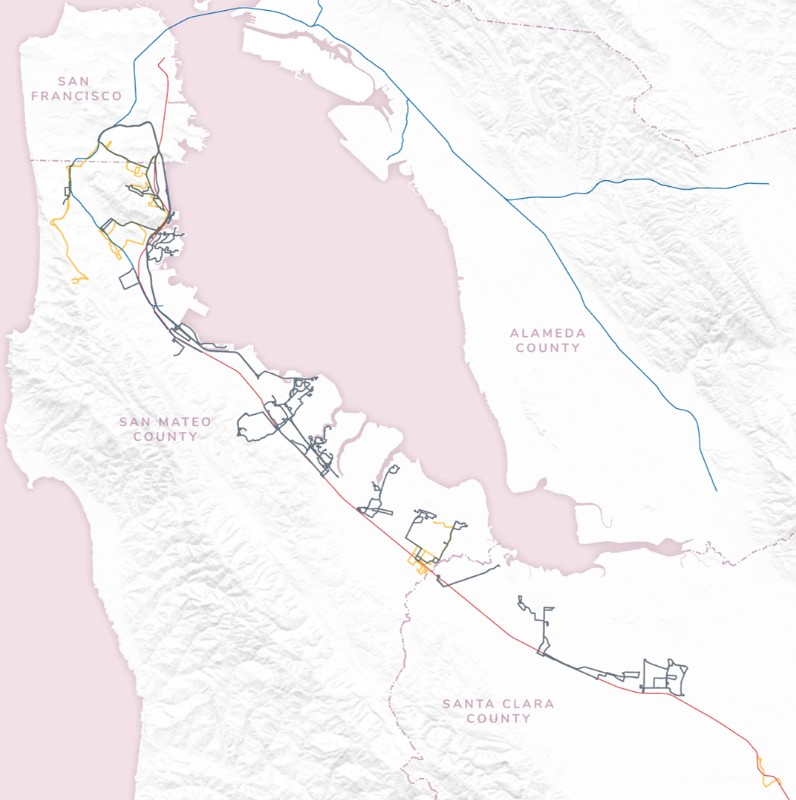The Peninsula Shuttle Study considers the past, present, and future of the Peninsula Shuttle Program, a multi-agency public-private partnership of first/last mile and community transit operations in San Mateo and Santa Clara Counties.
Study Outcomes
The study identifies several service and management recommendations that are intended to strengthen the shuttle program’s responsiveness to changing conditions as well as support ridership recovery and growth. These include updating the evaluation and funding process, modernizing data management and rider communication tools, and simplifying management roles and responsibilities.
The study identified four primary challenges facing the program, described below.
Read the Peninsula Shuttle Study final report.
View the Peninsula Shuttle Study appendices.
Need to find a shuttle?
Caltrain Shuttles | SamTrans Shuttles | SMCTD Shuttle
Key Program Challenges
Inconsistent Performance: Prior to the pandemic, shuttle ridership was decreasing overall even as Caltrain ridership was increasing. Some routes were doing very well, while others saw a significant drop in ridership due to reliability and competition from other services.
Shifting Demand: There remains uncertainty around post-pandemic travel behavior and ridership recovery. At the same time, commercial and residential growth could necessitate a significant expansion of shuttle service in some cities.
Difficulty Finding Shuttles: Lack of shuttle information and infrastructure creates barriers to ridership growth. Shuttles are not included in most SamTrans materials, and some cannot be found in trip planners like Google Maps. Not all shuttle stops have signage and sidewalk access.
Organizational Complexity: Many agencies are involved in often overlapping roles. No single agency has the resources needed to cover the full range of shuttle management responsibilities.
Study Recommendations
To address the key program challenges, the following recommendations were proposed:
Refresh Shuttle Evaluation Process: Shuttle Call for Projects grants should be awarded based on a more data-driven evaluation approach that prioritizes maximizing ridership and improving equitable access to regional transit.
Modernize Data Management: Shuttle data practices should be updated to reduce administrative overhead and improve the program’s responsiveness to changing needs. All shuttles should be equipped with real-time tracking and passenger counter to improve monitoring.
Enhance Rider Communication: Shuttles should be presented alongside buses as a coordinated network. Routes should be published in SamTrans’ bus network map and website along with third-party trip planning and real-time tracking apps.
Simplify Core Management Roles: Shuttle management roles should be simplified to enable a renewed focus on riders and community. Commute.org and cities should lead the planning and coordination of all shuttles, while SamTrans should operate most shuttles via a consolidated vendor contract.
Study Timeline
The final study document and recommendations were adopted by the SamTrans Board of Directors at the November 2021 meeting, with review from SMCTA, PCJPB, CCAG, and Commute.org Boards.
SamTrans, Caltrain, SMCTA, Commute.org and CCAG staff will work to implement the recommendations over the coming years.
To accommodate changes to the SMCTA Shuttle Call for Project evaluation criteria, the Fiscal Year 2021/2022 CFP cycle and agreements will be extended by a year for Fiscal Year 2023. To find out more about future Shuttle CFPs, please visit SMCTA’s CFP webpage here.
The study documents challenges and opportunities facing the shuttle program from the perspectives of riders, agency staff, and public and private sector stakeholders. In total, this study involved over 50 agencies and private entities affiliated with the program and incorporates rider feedback from nearly 1,000 surveys.
The study was jointly funded by SamTrans and Caltrain in coordination with the San Mateo County Transportation Authority (SMCTA), City/County Association of Governments of San Mateo County (C/CAG), and Commute.org.
What is a Shuttle?
In the Peninsula context, a shuttle is a short transit service oriented toward first/last mile or an individual community’s needs. While “shuttle” implies a small vehicle, a range of vehicle types are in operation, including some full-size 45-foot buses. Shuttles can serve commute or non-commute trips, and may be operated by cities, transit agencies, or the private sector, either directly or via a contractor. Shuttles are funded directly by local jurisdictions or the private sector, often with support from grants by SMCTA, C/CAG, MTC, and the Bay Area Air Quality Management District.
Shuttles have traditionally been grouped into two categories: commuter shuttles and community shuttles. Commuter shuttles provide first/last mile connections to/from regional transit primarily to access employment centers during peak periods.
Community shuttles provide all-day, midday, or weekend service generally within a single community for basic needs like shopping, dining, and medical appointments, often serving transit-reliant populations. However, the distinctions between commuter and community shuttles have been increasingly blurred as more shuttles serve both markets.
The Peninsula shuttle program serves most cities in San Mateo County as well as some in Santa Clara County (Figure 1), which have been suspended due to the COVID-19 Pandemic as of 2020. Of 45 routes in 2019, 37 operated in San Mateo County and eight routes operated in Santa Clara County (affiliated with the program through funding or grant sponsorship via Caltrain). In 2019, shuttles were operating in 18 cities with service to 17 regional transit stations, and was managed by at least 14 different public and private sector entities.
Many shuttles operate on the Peninsula beyond this shuttle program. These include those operated by large employers, city-run shuttles not funded by the program, and even some shuttle-like fixed-route and on-demand bus services provided by SamTrans and VTA. Because these services are not part of the Peninsula shuttle program funded by SamTrans, Caltrain, the SMCTA, or their partners, they are outside the scope of this study.

Shuttles by the Numbers
- Shuttles provide approximately 5,200 weekday boardings in 2019
- The operating cost of the program was $7.6 million, 34% coming from the private sector.
- There are 45 shuttles funded by SamTrans, Caltrain, and/or the SMCTA, serving 18 cities across three counties.
- Shuttles provide service to 16 Caltrain and BART stations
- These shuttles provide connections to 16 Caltrain and/or BART stations.
All numbers from 2019.

